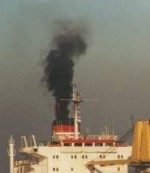 Is a ship the “greenest”, most efficient means of transportation or is the dirtiest? It is easy to be confused about hoe clean or dirty ocean transportation may be from reading the newspapers.
Is a ship the “greenest”, most efficient means of transportation or is the dirtiest? It is easy to be confused about hoe clean or dirty ocean transportation may be from reading the newspapers.
Transportation by water has always been the most efficient means of moving goods over distance. At the turn of the 19th century the cost of transporting an item across the Atlantic by ship was roughly the same cost as moving it 30 miles inland. With canals, railroads and highways, overland efficiency has improved, but, nevertheless, things haven’t changed so much.
A study by National Geographic on the transport of wines reflects this, as expressed by the carbon footprint of the shipment. If you live in New York, a French wine, transported by ship, can have a carbon footprint of only an equivalent to only 0.3 pounds of CO2, whereas a California wine, transported overland by truck, has a carbon footprint of 4.4 pounds.
Ship or Truck Transport Makes All the Difference in Wine’s Carbon Footprint
There are one thing I take away from this: Sending things by ship over long distances is pretty darn efficient —to the degree that sending a bottle of wine from Chile or Australia to Los Angeles by ship has similar emissions that driving it in a truck the 430 miles from Napa to Southern California.
So, ships have the lowest carbon footprint and therefore are the greenest form of transportation possible? Not necessarily, at least if you believe the headlines in the newspapers or all the purple prose. The Daily Mail from last November gets a bit over the top:
How 16 ships create as much pollution as all the cars in the world
Award-winning science writer Fred Pearce – environmental consultant to New Scientist and author of Confessions Of An Eco Sinner – reveals that the super-ships that keep the West in everything from Christmas gifts to computers pump out killer chemicals linked to thousands of deaths because of the filthy fuel they use.
However you look at it, the super-ships are rogues on the high seas, operating under pollution standards long since banished on land; warming the planet and killing its inhabitants. Santa’s sleigh, they are not.
Unfortunately the article is hatchet job. The headline is simply wrong. If it said that “16 ships create as much of certain types of pollution as all the cars in the world,” it would be closer to the truth. The problem is that large ships tend to burn residual fuel oil, Bunker C, which has a higher sulfur content and higher nitrogen oxide emissions than more refined fuels like gasoline. Low sulfulr gasoline is required in Europe and the the United States these days, so noting that any ship burning Bunker C creates more sulfur pollution than automobiles is not a very informative claim, particularly as the article never notes how much sulfur is put into the atmosphere by oil or coal burning power plants.
The article does note with alarm that global shipping may produce almost one billion tons of carbon dioxide yearly, which if my back of the envelope calculations are correct, is roughly 10% of the cargo dioxide produced by automobiles. Ships create far less CO2 pollution that cars, trucks or trains.
IMO (the International Maritime Organization) has been working to reduce global shipping pollution for several decades now. The current Protocol for the Prevention of Air Pollution from Ships steadily reduces allowable sulphur oxide (SOx) emissions from ships from the current cileing of 4.5% now to 3.5% by 2012 and to 0.50% by 2020.
So how dirty are ships? (Compared to many coal powered powered plants, they are extremely clean.) Ships remain the most energy efficient means of transportation. They have a significantly lower carbon footprint that cars, truck or trains. As with any plant burning residual fuel, they emit sulphur and nitrogen oxides, but the amount of these pollutants emitted is being dramatically reduced. Whether the reductions are fast enough, or as some in the industry would argue, too fast, is another very interesting discussion.
